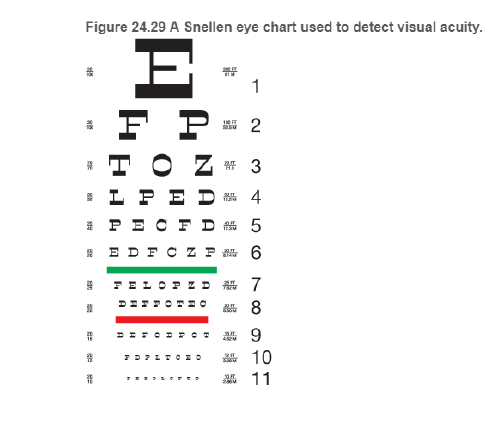
Concept explainers
BIO What is 20/20 vision? Vision is often measured using the Snellen eye chart, devised by Dutch ophthalmologist Herman Snellen in 1862 (see Figure 24.29). With normal vision (20/20 vision), you can distinguish a letter that is 8.8 mm high from other letters of similar height at a distance of 6.1 m (20 ft) (the Snellen chart in the figure is smaller than normal size). If your vision is 20/40, the letters must be twice as high to be distinguishable. Alternatively, a person with 20/40 vision could distinguish letters from 20 ft that a person with 20/20 vision can distinguish at 40 ft. Someone with 20/60 vision could distinguish letters at 20 ft that someone with 20/20 vision could distinguish at 60 ft.
Does the Rayleigh criterion limit visual resolution? Assume that the eye’s pupil is 5.0 mm in diameter for 500-nm light The Rayleigh criterion angular deflection for such light entering the eye's pupil is
If the Rayleigh criterion limited visual resolution, then from a distance of 6.1 m, you should be able to distinguish details in shapes of size

A hawk's vision is said to be 20/5. If so, the hawk can distinguish 8.8-mm-tall letters from about what distance?
a. 5ft
b. 10 ft
c. 40 ft
d. 80 ft
e. 120 ft
Want to see the full answer?
Check out a sample textbook solution
Chapter 24 Solutions
Pearson eText for College Physics: Explore and Apply -- Instant Access (Pearson+)
Additional Science Textbook Solutions
Introduction to Electrodynamics
The Cosmic Perspective
Conceptual Physical Science (6th Edition)
Physics: Principles with Applications
Physics for Scientists and Engineers with Modern Physics
- Why is your vision so blurry when you open your eyes while swimming under water? How does a face mask enable clear vision?arrow_forwardThe normal power for distant vision is 50.0 D. A young woman with normal distant vision has a 10.0% ability to accommodate (that is, increase) the power of her eyes. What is the closest object she can see clearly?arrow_forwardEndoscopes are medical instruments used to examine the gastrointestinal tract and other cavities inside the body. The light required for examination is conducted from an outside source along a long, flexible bundle of optical fibers to the tip, where it exits and illuminates the internal cavity. A lens on the lip collects an image of the lighted cavity and another fiber bundle conducts the image back along the endoscope to an eyepiece for viewing (Fig. P22.52). If each fiber in the bundle has diameter d = 1.00 104 m and refractive index n = 1.40, find the smallest outside radius R permitted for a bend in the fiber if no light is to escape. Figure P22.52arrow_forward
- (a) A laser vision correction reshaping the cornea of a myopic patient reduces the power of his eye by 9.00 D, with a 5.0 uncertainty in the final correction. What is the range of diopters for spectacle lenses that this person might need after LASIK procedure? (b) Was the person nearsighted or farsighted before the procedure? How do you know?arrow_forward(a) Use the thin-lens equation to derive an expression for q in terms of f and p. (b) Prove that for a real object and a diverging lens, the image must always be virtual. Hint: Set f = |f| and show that q must be less than zero under the given conditions. (c) For a real object and converging lens, what inequality involving p and f must hold if the image is to be real?arrow_forwardThe power for normal distant vision is 50.0 D. A severely myopic patient has a far point of 5.00 cm. By how many diopters should the power of his eye be reduced in laser vision correction to obtain normal distant vision for him?arrow_forward
- Suppose a man stands in front of a mm-or as show below. His eyes are 1.65 m above the floor and the top of his head is 0.13 m higher. Find the height above the floor of the top and bottom of the smallest minor in which he can see both the top of his head and his feet. How is this distance related to the man’s height?arrow_forward. A person looks at a statue that is 2 m tall. The image on the persons retina is inverted and 0.005 m high. What is the magnification?arrow_forwardA cataract is cloudiness in the lens of the eye. Is light dispersed or diffused by it?arrow_forward
- A water fountain is at the center of a circular pool as shown in Figure P1.59. A student walks around the pool and measures its circumference C. Next, he stands at the edge of the pool and uses a protractor to measure the angle of elevation of his sightline to the top of the water jet. How high is the fountain?arrow_forwardPierre de Fermat (16011665) showed that whenever light travels from one point to another, its actual path is the path that requires the smallest time interval. This statement is known as Fermats principle. The simplest example is for light propagating in a homogeneous medium. It moves in a straight line because a straight line is the shortest distance between two points. Derive Snells law of refraction from Fermats principle. Proceed as follows. In Figure P34.54, a light ray travels from point P in medium 1 to point Q in medium 2. The two points are, respectively, at perpendicular distances a and b from the interface. The displacement from P to Q has the component d parallel to the interface, and we let x represent the coordinate of the point where the ray enters the second medium. Let t = 0 be the instant the light starts from P. (a) Show that the time at which the light arrives at Q is t=r1v1+r2v2=n1a2+x2c+n2b2+(dx)2c (b) To obtain the value of x for which t has its minimum value, differentiate t with respect to x and set the derivative equal to zero. Show that the result implies n1xa2+x2=n2(dx)b2+(dx)2 (c) Show that this expression in turn gives Snells law. n1sin1=n2sin2 Figure P34.54 Problems 54 and 55.arrow_forwardFind the radius of a star’s image on the retina of an eye if its pupil is open to 0.65 cm and the distance from the pupil to the retina is 2.8 cm. Assume =550 nm.arrow_forward
 Physics for Scientists and EngineersPhysicsISBN:9781337553278Author:Raymond A. Serway, John W. JewettPublisher:Cengage Learning
Physics for Scientists and EngineersPhysicsISBN:9781337553278Author:Raymond A. Serway, John W. JewettPublisher:Cengage Learning Physics for Scientists and Engineers with Modern ...PhysicsISBN:9781337553292Author:Raymond A. Serway, John W. JewettPublisher:Cengage Learning
Physics for Scientists and Engineers with Modern ...PhysicsISBN:9781337553292Author:Raymond A. Serway, John W. JewettPublisher:Cengage Learning College PhysicsPhysicsISBN:9781305952300Author:Raymond A. Serway, Chris VuillePublisher:Cengage Learning
College PhysicsPhysicsISBN:9781305952300Author:Raymond A. Serway, Chris VuillePublisher:Cengage Learning Principles of Physics: A Calculus-Based TextPhysicsISBN:9781133104261Author:Raymond A. Serway, John W. JewettPublisher:Cengage Learning
Principles of Physics: A Calculus-Based TextPhysicsISBN:9781133104261Author:Raymond A. Serway, John W. JewettPublisher:Cengage Learning Physics for Scientists and Engineers, Technology ...PhysicsISBN:9781305116399Author:Raymond A. Serway, John W. JewettPublisher:Cengage Learning
Physics for Scientists and Engineers, Technology ...PhysicsISBN:9781305116399Author:Raymond A. Serway, John W. JewettPublisher:Cengage Learning College PhysicsPhysicsISBN:9781285737027Author:Raymond A. Serway, Chris VuillePublisher:Cengage Learning
College PhysicsPhysicsISBN:9781285737027Author:Raymond A. Serway, Chris VuillePublisher:Cengage Learning





